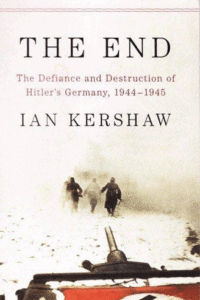From the JFR Library – January 2013
This month The Jewish Foundation for the Righteous (JFR) recommends The End: The Defiance and Destruction of Hitler’s Germany, 1944-1945, by Ian Kershaw. The book was reviewed by James J. Sheehan for The New York Times.
 “By the morning of April 18, 1945, the war in Ansbach, a picturesque town in southern Germany, was just about over. With the Wehrmacht in retreat and the United States Army a few miles away, surrender seemed the only option. But Ansbach’s military commander, a middle-aged air force colonel named Ernst Meyer, was determined to fight to the bitter end. In an effort to avert a catastrophe, Robert Limpert, a 19-year-old theology student, destroyed what he thought were the phone lines between the town and local army headquarters. Turned in by two members of the Hitler Youth, Limpert was arrested, summarily tried and publicly executed while a crowd of his fellow citizens, some cheering, most silent, looked on. A few hours later, after Meyer had fled and Ansbach was captured without a fight, American troops cut down Limpert’s body from where it had been left hanging in the town hall square.
“By the morning of April 18, 1945, the war in Ansbach, a picturesque town in southern Germany, was just about over. With the Wehrmacht in retreat and the United States Army a few miles away, surrender seemed the only option. But Ansbach’s military commander, a middle-aged air force colonel named Ernst Meyer, was determined to fight to the bitter end. In an effort to avert a catastrophe, Robert Limpert, a 19-year-old theology student, destroyed what he thought were the phone lines between the town and local army headquarters. Turned in by two members of the Hitler Youth, Limpert was arrested, summarily tried and publicly executed while a crowd of his fellow citizens, some cheering, most silent, looked on. A few hours later, after Meyer had fled and Ansbach was captured without a fight, American troops cut down Limpert’s body from where it had been left hanging in the town hall square.
What happened that sunny spring day in Ansbach captures many of the elements Ian Kershaw examines in his powerful new book: a core of die-hard fanatics, an obedient and still functioning state structure and, perhaps most striking of all, a compliant public that did nothing to interfere with the dying regime’s final murderous spasms….
‘The End’ tells the story of the German war from the aftermath of the failed attempt to assassinate Hitler in July 1944 until late May 1945 when, three weeks after the Führer’s suicide, his successors were arrested and their government dissolved. This is, the subtitle tells us, a tale of both defiance and destruction. As Kershaw shows in harrowing detail, the sheer quantity of human suffering in World War II’s concluding chapter defies imagination. During the first four months of 1945, the Allies dropped 471,000 tons of bombs on German cities, twice as much as in all of 1943. Tens of thousands of people died, millions were left homeless. In the east, millions desperately sought to escape the horrors of rape and murder inflicted by invading Soviet troops, who were intent on avenging the German Army’s barbaric occupation of their homeland….
And of course those who suffered most were the Nazi regime’s own victims, forced laborers from all over conquered Europe, prisoners of war on the Eastern front and especially the surviving remnant of Europe’s Jews, many of whom perished on senseless death marches that emptied concentration camps before they could be captured by enemy forces. In Auschwitz, for example, where over a million people had been murdered, only 7,000 ill and starving inmates remained when Soviet troops arrived in January 1945….
At the core of Kershaw’s book is a single set of questions: Why did the regime last long after the war was obviously lost, why did the German Army keep fighting to the end and why, in the final hours of its existence, were the citizens of Nazi Germany willing and able to take the lives of those few who, like Robert Limpert, tried to avert more pointless destruction? There are, Kershaw recognizes, no simple answers to these questions… The decisive factors are all to be found in Germany itself, in what Kershaw calls the “structures of rule and mentalities” that kept the regime going at such enormous cost, long after any hope of victory had been extinguished….
Kershaw’s analysis works best when he is discussing the military and civilian elites. He convincingly uncovers the compound of personal loyalty, ideological conviction and selfish calculation that motivated those at the apex of power. The further we move from the top, however, the more difficult it becomes to find satisfactory explanations for the country’s continued capacity to function. Kershaw succeeds in clearing away a great many misconceptions, he deploys an impressive amount of evidence about the variety and complexity of public opinion and he brilliantly describes the ghastly fate of many ordinary Germans. No one has written a better account of the human dimensions of Nazi Germany’s end. But despite his enormous learning and remarkable interpretive skills, we remain perplexed by the widespread passivity of the majority of those who, like that crowd around the gallows in Ansbach, continued to obey a government that had nothing left to offer them but death and destruction. “
— James J. Sheehan for The New York Times
To purchase this book, click here. This link will take you to our bookstore, from where your purchase through Amazon.com helps support the work of The Jewish Foundation for the Righteous.



